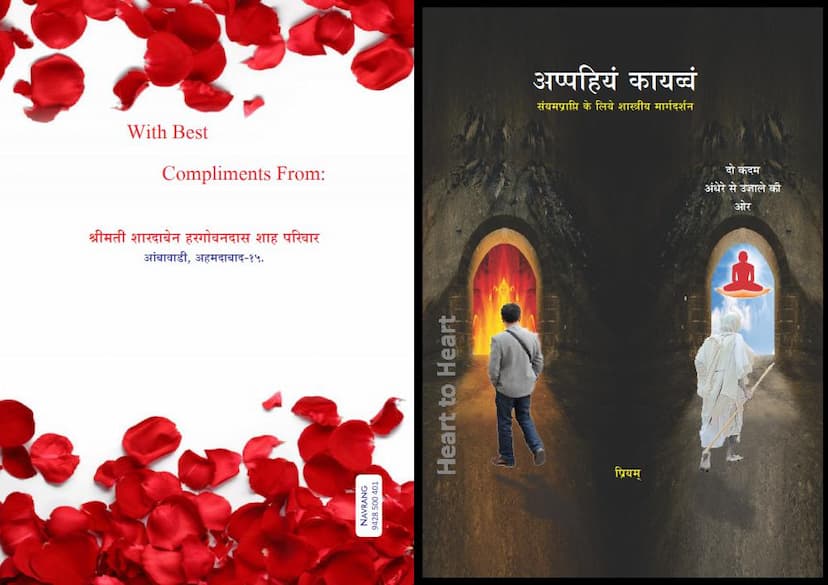Appahiyam Kayavvam
Added to library: September 1, 2025

Summary
This document, "Appahiyam Kayavvam" (Self-Benefit Should Be Done), authored by Priyam and published by Ashapuran Parshwanath Jain Gyanbhandar, serves as a classical guide for achieving Sanyam (self-restraint or renunciation) within Jainism. The core message emphasizes that the pursuit of Sanyam is not bound by age or marital status, but rather by Vairagya (detachment).
The text addresses common concerns and misconceptions regarding eligibility for Sanyam, particularly for women. It clarifies that being married or having children does not disqualify a woman from renunciation. However, the scriptures do stipulate certain conditions for women: they should not be pregnant, and their children should not be extremely young. This is to ensure the well-being of the children and the proper upholding of Jain principles. The text stresses that marriage is a worldly bond, and once renunciation is embraced, the individual is free from such earthly ties.
Key Themes and Principles:
- The Primacy of Self-Benefit (Aatmhit): The fundamental principle is that one's own spiritual welfare (Aatmhit) is paramount. While societal, familial, and bodily duties exist, the ultimate responsibility lies with the soul. The text argues that the body is impermanent and will eventually perish, while the soul is eternal. Neglecting the soul's liberation for transient worldly concerns is seen as a grave error.
- Vairagya as the Driving Force: True Sanyam stems from genuine detachment from worldly pleasures and attachments. This detachment is what enables an individual to transcend the cycles of birth and death.
- Dharma and Duty: The text explores the hierarchy of duties. While one has duties towards family, society, and the body, the duty towards one's soul (Aatmhit) supersedes all others. It acknowledges that at times, one may have to prioritize, and in such instances, the greater benefit of the soul should be the guiding factor.
- Overcoming Obstacles: The document addresses the perceived difficulties in attaining Sanyam for those who are married or have responsibilities. It asserts that these are often mental barriers or due to a lack of strong determination. The text encourages individuals to overcome these obstacles with strong resolve and appropriate spiritual effort.
- The Role of a Guru: A crucial aspect highlighted is the necessity of a learned and virtuous Guru (Saddguru). A Guru provides guidance, helps in understanding complex situations, and aids in self-assessment. Complete surrender and dedication to a Guru are deemed essential for success in both monastic and lay life.
- Scriptural Authority and Examples: The text draws upon various Jain scriptures like the Nishiith Sutra, Uttaradhyayana Sutra, Sutrakritanga, and Panchasutra to support its arguments. It also uses historical examples and anecdotes, such as those of Jambu Swami and Shivkumar, to illustrate the power of Vairagya and Purusharth (spiritual effort) in achieving Sanyam and liberation.
- The Concept of Civil Death: Renunciation is equated to a "civil death" in the sense that the individual ceases to be bound by worldly legal and social obligations related to their previous life. This is exemplified by the advice given to individuals regarding inheritance laws.
- No Liability for Others' Misconduct: The text strongly asserts that if a spouse or family member deviates from the righteous path after an individual has taken Sanyam, the renounced individual bears no fault. Each soul is responsible for its own karma. Examples of great souls whose wives fell into unrighteous paths are given, emphasizing that their liberation was not hindered.
- The Power of True Desire: A genuine and strong desire for Sanyam can overcome thousands of adverse circumstances. This inner conviction possesses the power to transform the environment and conquer even the most stubborn karmic obstacles.
- Methods of Seeking Permission: When seeking permission for renunciation from family, the text suggests attempting to enlighten them first. If that's not possible, gaining their consent is advised. If financial concerns are a hindrance, establishing a stable source of income for the family is recommended. In situations where direct permission is difficult to obtain due to attachment or misunderstanding, the text suggests employing subtle, ethical means to gain approval.
- Self-Reliance in Spiritual Pursuit: Ultimately, the text stresses that spiritual progress is an individual journey. While caring for others is good, it should not come at the cost of one's own spiritual upliftment. The ultimate goal is the liberation of the soul, and this requires focused effort and unwavering devotion to one's own spiritual well-being.
In essence, "Appahiyam Kayavvam" is a call to action for all those who aspire to Sanyam. It demystifies the process, encourages unwavering resolve, and emphasizes the ultimate importance of self-spiritual benefit, guided by scriptural wisdom and the grace of a Guru. It challenges individuals to prioritize their soul's liberation over worldly attachments and perceived societal obligations.